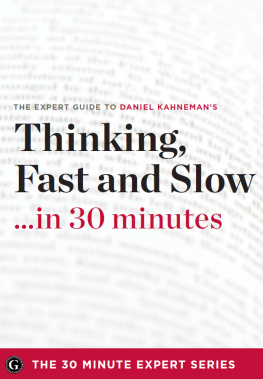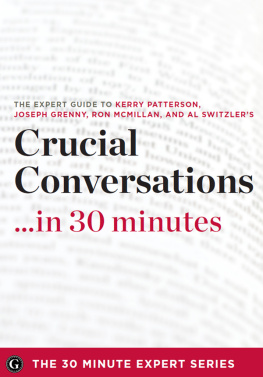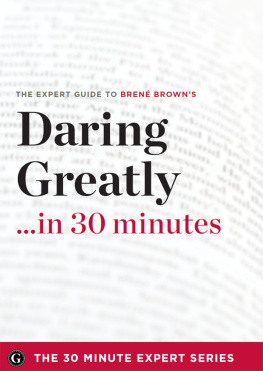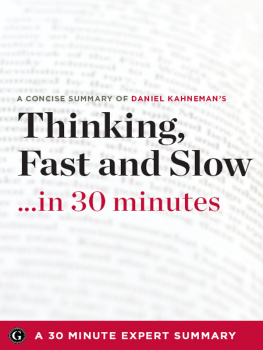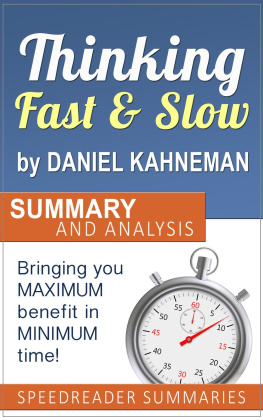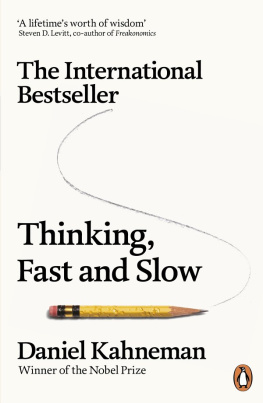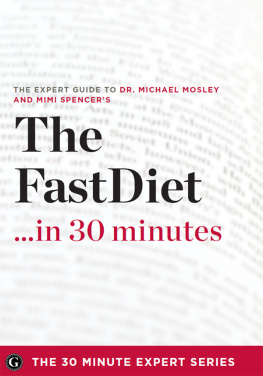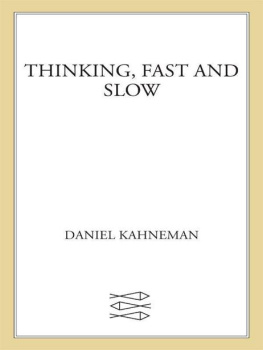The 30 Minute Expert Series - Thinking Fast and Slow in 30 Minutes: The Expert Guide to Daniel Kahnemans Critically Acclaimed Book
Here you can read online The 30 Minute Expert Series - Thinking Fast and Slow in 30 Minutes: The Expert Guide to Daniel Kahnemans Critically Acclaimed Book full text of the book (entire story) in english for free. Download pdf and epub, get meaning, cover and reviews about this ebook. year: 2013, publisher: Callisto Media, genre: Politics. Description of the work, (preface) as well as reviews are available. Best literature library LitArk.com created for fans of good reading and offers a wide selection of genres:
Romance novel
Science fiction
Adventure
Detective
Science
History
Home and family
Prose
Art
Politics
Computer
Non-fiction
Religion
Business
Children
Humor
Choose a favorite category and find really read worthwhile books. Enjoy immersion in the world of imagination, feel the emotions of the characters or learn something new for yourself, make an fascinating discovery.
- Book:Thinking Fast and Slow in 30 Minutes: The Expert Guide to Daniel Kahnemans Critically Acclaimed Book
- Author:
- Publisher:Callisto Media
- Genre:
- Year:2013
- Rating:4 / 5
- Favourites:Add to favourites
- Your mark:
Thinking Fast and Slow in 30 Minutes: The Expert Guide to Daniel Kahnemans Critically Acclaimed Book: summary, description and annotation
We offer to read an annotation, description, summary or preface (depends on what the author of the book "Thinking Fast and Slow in 30 Minutes: The Expert Guide to Daniel Kahnemans Critically Acclaimed Book" wrote himself). If you haven't found the necessary information about the book — write in the comments, we will try to find it.
We strongly encourage you to purchase the original book, Thinking, Fast and Slow, by Daniel Kahneman.
How are decisions made? When can you trust fast, intuitive judgment, and when is it biased and unreliable? Learn how to transform your thinking to help avoid overconfidence and become a better decision maker.
Thinking, Fast and Slow ...in 30 Minutes is the essential guide to quickly understanding the fundamental components of decision making outlined in Daniel Kahnemans best-selling book, Thinking, Fast and Slow.
Thinking, Fast and Slow ...in 30 Minutes offers:
- Critical reception to the work, highlighting essential arguments by major publications and thought leaders
- Key concepts from the book, including an explanation heuristics and biases, the two selves, and the two distinct thinking systemsthe intuitive System 1, and the effortful System 2
- Illustrative case studies demonstrating Kahnemans groundbreaking research in behavioral economics
- Realworld applications for utilizing Kahnemans theories in everyday life
In Thinking, Fast and Slow, best-selling author Daniel Kahneman has compiled his many years of innovative research to offer practical knowledge and insights into how peoples minds make decisions. Challenging the standard model of judgment, Kahneman aims to enhance the everyday language about thinking to more accurately discuss, diagnose, and reduce poor judgment.
Presenting a framework for how the fast System 1 and the slow System 2 impact the mind, Thinking, Fast and Slow reveals the far-reaching impact of cognitive biasesfrom creating public policy to playing the stock market to increasing personal happinessand provides tools for applying behavioral economics toward better decision making.
About the 30 Minute Expert Series
Offering a concise exploration of a books ideas, history, application, and critical reception, each text in the 30 Minute Expert Series is designed for busy individuals interested in acquiring an indepth understanding of seminal works. The 30 Minute Expert Series offers detailed analyses, critical presentations of key ideas and their application, extensive reading lists for additional information, and contextual understanding of the work of leading authors. Designed as companions to the original work, the 30 Minute Expert Series enables readers to develop expert knowledge of an important work ...in 30 minutes.
The 30 Minute Expert Series: author's other books
Who wrote Thinking Fast and Slow in 30 Minutes: The Expert Guide to Daniel Kahnemans Critically Acclaimed Book? Find out the surname, the name of the author of the book and a list of all author's works by series.

